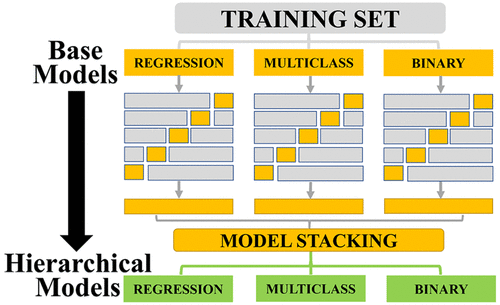当前位置:
X-MOL 学术
›
Chem. Res. Toxicol.
›
论文详情
Our official English website, www.x-mol.net, welcomes your
feedback! (Note: you will need to create a separate account there.)
Hierarchical Quantitative Structure-Activity Relationship Modeling Approach for Integrating Binary, Multiclass, and Regression Models of Acute Oral Systemic Toxicity.
Chemical Research in Toxicology ( IF 3.7 ) Pub Date : 2020-02-05 , DOI: 10.1021/acs.chemrestox.9b00259 Xinhao Li 1 , Nicole C Kleinstreuer 2, 3 , Denis Fourches 1
Chemical Research in Toxicology ( IF 3.7 ) Pub Date : 2020-02-05 , DOI: 10.1021/acs.chemrestox.9b00259 Xinhao Li 1 , Nicole C Kleinstreuer 2, 3 , Denis Fourches 1
Affiliation

|
Reliable in silico approaches to replace animal testing for the evaluation of potential acute toxic effects are highly demanded by regulatory agencies. In particular, quantitative structure-activity relationship (QSAR) models have been used to rapidly assess chemical induced toxicity using either continuous (regression) or discrete (classification) predictions. However, it is often unclear how those different types of models can complement and potentially help each other to afford the best prediction accuracy for a given chemical. This paper presents a novel, dual-layer hierarchical modeling method to fully integrate regression and classification QSAR models for assessing rat acute oral systemic toxicity, with respect to regulatory classifications of concern. The first layer of independent regression, binary, and multiclass models (base models) were solely built using computed chemical descriptors/fingerprints. Then, a second layer of models (hierarchical models) were built by stacking all the cross-validated out-of-fold predictions from the base models. All models were validated using an external test set, and we found that the hierarchical models did outperform the base models for all three end points. The hierarchical quantitative structure-activity relationship (H-QSAR) modeling method represents a promising approach for chemical toxicity prediction and more generally for stacking and blending individual QSAR models into more predictive ensemble models.
中文翻译:

集成急性口腔系统毒性的二元,多类和回归模型的层次定量结构-活动关系建模方法。
监管机构强烈要求采用可靠的计算机方法替代动物试验,以评估潜在的急性毒性作用。特别是,定量构效关系(QSAR)模型已用于使用连续(回归)或离散(分类)预测快速评估化学诱导的毒性。但是,通常不清楚这些不同类型的模型如何互补和潜在地互相帮助,以提供给定化学物质的最佳预测精度。本文提出了一种新颖的双层层次建模方法,该方法完全集成了回归和分类QSAR模型,以评估所关注的监管分类对大鼠急性口腔系统毒性。独立回归的第一层,二进制 和多类模型(基础模型)仅使用计算出的化学描述符/指纹建立。然后,通过堆叠来自基础模型的所有交叉验证的失叠预测来构建第二层模型(分层模型)。所有模型都使用外部测试集进行了验证,我们发现分层模型的确优于所有三个端点的基础模型。分层定量结构-活性关系(H-QSAR)建模方法代表了一种有前途的化学毒性预测方法,更普遍地是将单个QSAR模型堆叠和混合为更具预测性的整体模型。通过堆叠来自基础模型的所有交叉验证的失叠预测来构建第二层模型(层次模型)。所有模型都使用外部测试集进行了验证,我们发现分层模型的确优于所有三个端点的基础模型。分层定量结构-活性关系(H-QSAR)建模方法代表了一种有前途的化学毒性预测方法,更普遍地是将单个QSAR模型堆叠和混合为更具预测性的整体模型。通过堆叠来自基础模型的所有交叉验证的失叠预测来构建第二层模型(层次模型)。所有模型都使用外部测试集进行了验证,我们发现分层模型的确优于所有三个端点的基础模型。分层定量结构-活性关系(H-QSAR)建模方法代表了一种有前途的化学毒性预测方法,更普遍地是将单个QSAR模型堆叠和混合为更具预测性的整体模型。
更新日期:2020-02-06
中文翻译:

集成急性口腔系统毒性的二元,多类和回归模型的层次定量结构-活动关系建模方法。
监管机构强烈要求采用可靠的计算机方法替代动物试验,以评估潜在的急性毒性作用。特别是,定量构效关系(QSAR)模型已用于使用连续(回归)或离散(分类)预测快速评估化学诱导的毒性。但是,通常不清楚这些不同类型的模型如何互补和潜在地互相帮助,以提供给定化学物质的最佳预测精度。本文提出了一种新颖的双层层次建模方法,该方法完全集成了回归和分类QSAR模型,以评估所关注的监管分类对大鼠急性口腔系统毒性。独立回归的第一层,二进制 和多类模型(基础模型)仅使用计算出的化学描述符/指纹建立。然后,通过堆叠来自基础模型的所有交叉验证的失叠预测来构建第二层模型(分层模型)。所有模型都使用外部测试集进行了验证,我们发现分层模型的确优于所有三个端点的基础模型。分层定量结构-活性关系(H-QSAR)建模方法代表了一种有前途的化学毒性预测方法,更普遍地是将单个QSAR模型堆叠和混合为更具预测性的整体模型。通过堆叠来自基础模型的所有交叉验证的失叠预测来构建第二层模型(层次模型)。所有模型都使用外部测试集进行了验证,我们发现分层模型的确优于所有三个端点的基础模型。分层定量结构-活性关系(H-QSAR)建模方法代表了一种有前途的化学毒性预测方法,更普遍地是将单个QSAR模型堆叠和混合为更具预测性的整体模型。通过堆叠来自基础模型的所有交叉验证的失叠预测来构建第二层模型(层次模型)。所有模型都使用外部测试集进行了验证,我们发现分层模型的确优于所有三个端点的基础模型。分层定量结构-活性关系(H-QSAR)建模方法代表了一种有前途的化学毒性预测方法,更普遍地是将单个QSAR模型堆叠和混合为更具预测性的整体模型。











































 京公网安备 11010802027423号
京公网安备 11010802027423号